Lodoicea
Lodoicea, commonly known as the sea coconut, coco de mer, or double coconut, is a monotypic genus in the palm family. The sole species, Lodoicea maldivica, is endemic to the islands of Praslin and Curieuse in the Seychelles. It formerly also was found on the small islets of St Pierre, Chauve-Souris and Ile Ronde (Round Island), all located near Praslin, but had become extinct there for a time until recently reintroduced. The name of the genus, Lodoicea, may be derived from Lodoicus, the Latinised form of Louis, in honour of King Louis XV of France. Other sources say that Lodoicea is from Laodice, the daughter of Priam and Hecuba. [3]
| Lodoicea | |
|---|---|
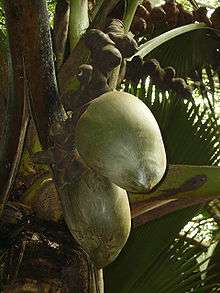 | |
| Habit, with fruit | |
| Scientific classification | |
| Kingdom: | Plantae |
| Clade: | Tracheophytes |
| Clade: | Angiosperms |
| Clade: | Monocots |
| Clade: | Commelinids |
| Order: | Arecales |
| Family: | Arecaceae |
| Subfamily: | Coryphoideae |
| Tribe: | Borasseae |
| Genus: | Lodoicea Comm. ex DC. |
| Species: | L. maldivica |
| Binomial name | |
| Lodoicea maldivica (J.F.Gmelin) Persoon | |
| Synonyms[2] | |
|
List
| |
Description
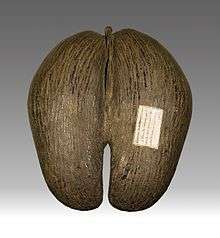
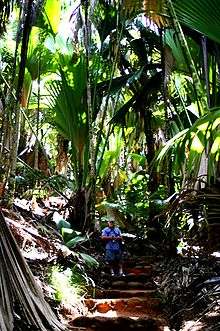
The tree generally grows to 25–34 m tall. The tallest on record, measured on the ground after felling, was 186 feet (56.7 meters) in total height.[4] The leaves are fan-shaped, 7–10 m long and 4.5 m wide with a 4 m petiole in mature plants. However juveniles produce much longer petioles; up to 29' 6" (9 meters)[5][6] or even 33 feet (10 meters).[7] It is dioecious, with separate male and female plants. The male flowers are arranged in a catkin-like inflorescence up to 1 m long which continues to produce pollen over a ten-year period; one of the longest living inflorescences known. The mature fruit is 40–50 cm in diameter and weighs 15–30 kg, and contains the largest seed in the plant kingdom. The fruit, which requires 6–7 years to mature and a further two years to germinate, is sometimes also referred to as the sea coconut, love nut, double coconut, coco fesse, or Seychelles nut.[8]
While the functional characteristics of Lodoicea are similar to other trees of monodominant forests in the humid tropics, its unique features include a huge seed, effective funnelling mechanism and diverse community of closely associated animals. These attributes suggest a long evolutionary history under relatively stable conditions.[9] Of the six monospecific endemic palms in Seychelles, Lodoicea is the "only true case of island gigantism among Seychelles flowering plants, a unique feature of Seychelles vegetation".[10] It holds five botanical records: It produces the largest wild fruit so far recorded, weighing up to 42 kg,(although domesticated pumpkins and watermelons can be much heavier); the mature seeds weighing up to 17.6 kg are the world's heaviest,[11][12][13] The seed upon germinating, produces the longest known cotyledon, up to four meters (13 feet). The female flowers are the largest of any palm.[12][13] and Lodoicea is the most efficient plant known at recovering nutrients from moribund leaves.[14][15]
Of the six endemic palms it is the only dioecious species, with male and female flowers located on different plants.[16]
Habit
Lodoicea is robust, solitary, up to 30 m tall with an erect, spineless, stem which is ringed with leaf scars (Calstrom, unpublished). The base of the trunk is of a bulbous form and this bulb fits into a natural bowl, or socket, about 2.5 ft in diameter and 18 inches in depth, narrowing towards the bottom. This bowl is pierced with hundreds of small oval holes about the size of a thimble with hollow tubes corresponding on the outside through which the roots penetrate the ground on all sides, never, however, becoming attached to the bowl; they are partially elastic, affording an almost imperceptible but very necessary "play" to the parent stem when struggling against the force of violent gales.
Leaves
The crown is a rather dense head of foliage with leaves that are stiff, palmate up to 10 m in diameter and petioles of two to four metres in length. The leaf is plicate at the base, cut one third or more into segments 4–10 cm broad with bifid end which are often drooping. A triangular cleft develops at the petiole base.[12] The palm leaves form a huge funnel that intercepts particulate material, especially pollen, which is flushed to the base of the trunk when it rains. In this way, Lodoicea improves its nutrient supply and that of its dispersal-limited offspring.[9]
Flowers
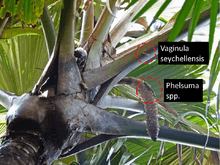
The clusters of staminate flowers are arranged spirally and are flanked by very tough leathery bracts. Each has a small bracteole, three sepals forming a cylindrical tube, and a three-lobed corolla. There are 17 to 22 stamens. The pistillate flowers are solitary and borne at the angles of the rachis and are partially sunken in it in the form of a cup. They are ovoid with three petals as well as three sepals.[12] It has been suggested that they may be pollinated by animals such as the endemic lizards which inhabit the forest where they occur.[17] Pollination by wind and rain are also thought to be important.[16] Only when Lodoicea begins to produce flowers, which can vary from 11 years to 45 or more, is it possible to visually determine the sex of the plant. The nectar and pollen are also food for several endemic animals e.g. bright green geckos (Phelsuma sp.), white slugs (Vaginula seychellensis) and insects.[18]
Inflorescence
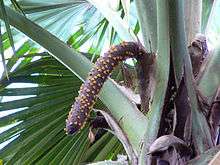
Inflorescences are interfoliar, lacking a covering spathe and shorter than the leaves. The staminate inflorescence is catkin-like, one to two metres long and generally terminal and solitary, sometimes two or three catkins may be present. The pistillate inflorescences are also one to two metres long unbranched and the flowers are borne on a zig-zagging rachilla.[13]
Fruit
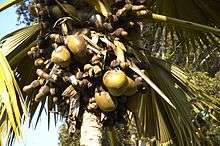
The fruit is bilobed, flattened, 40 to 50 cm long ovoid and pointed, and contains usually one but occasionally two to four seeds. The epicarp is smooth and the mesocarp is fibrous. The endosperm is thick, relatively hard, hollow and homogenous. The embryo sits in the sinus between the two lobes. During germination a tubular cotyledonary petiole develops that connects the young plant to the seed. The length of the tube is reported to reach about four metres.[12] In the Vallee de Mai the tube may be up to 10 m long.[17]
Lodoicea was once believed to be a sea-bean or drift seed, a seed evolved to be dispersed by the sea. However, it is now known that the viable nut is too dense to float, and only rotted out nuts can be found on the sea surface,[19] thus explaining why the trees are limited in range to just two islands.
Habitat
Lodoicea inhabit rainforests where there are deep, well-drained soils[13] and open exposed slopes; although growth is reduced on such eroded soils.[20]
History and mythology
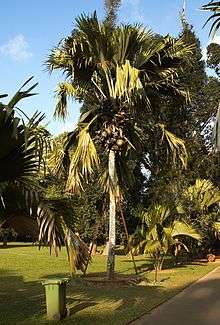
Formerly Lodoicea was known as Maldive coconut. Its scientific name, Lodoicea maldivica, originated before the 18th century when the Seychelles were uninhabited. In centuries past the coconuts that fell from the trees and ended up in the sea would be carried away eastwards by the prevailing sea currents. The nuts can only float after the germination process, when they are hollow. In this way many drifted to the Maldives where they were gathered from the beaches and valued as an important trade and medicinal item.[11][21] This association is reflected in one of the plant's archaic botanical names, Lodoicea callipyge Comm. ex J. St.-Hil., in which callipyge is from Greek words meaning 'beautiful buttocks'. Other botanical names used in the past include Lodoicea sechellarum Labill. and Lodoicea sonneratii (Giseke) Baill.
Until the true source of the nut was discovered in 1768 by Dufresne, it was believed by many to grow on a mythical tree at the bottom of the sea. European nobles in the sixteenth century would often have the shells of these nuts polished and decorated with valuable jewels as collectibles for their private galleries. The coco de mer tree is now a rare and protected species.
Uses
The species is grown as an ornamental tree in many areas in the tropics, and subsidiary populations have been established on Mahé and Silhouette Islands in the Seychelles to help conserve the species. The fruit is used in Siddha medicine, Ayurvedic medicine and also in traditional Chinese medicine. In food, it is typically found as flavor enhancers for soups in southern Chinese cuisine, such as that of Guangdong Province.
The seeds of Lodoicea have been highly prized over the centuries; their rarity caused great interest and high prices in royal courts, and the tough outer seed coat has been used to make bowls such as for Sufi/Dervish beggar-alms kashkul bowls and other instruments.[13]
Taxonomy
Lodoicea belongs to the Coryphoidae subfamily and tribe Borasseae. Borasseae is represented by four genera in Madagascar and one in Seychelles out of the seven worldwide. They are distributed on the coastlands surrounding the Indian ocean and the existing islands within. Borassus, the genus closest to Lodoicea, has about five species in the "old world," one species in Africa, one in India, South-East Asia and Malaysia, one in New Guinea and two species in Madagascar.[12]
Threats
The history of exploitation continues today, and the collection of nuts has virtually stopped all natural regeneration of populations[22] with the exception of the introduced population on Silhouette. This palm has been lost from the wild from three Seychelles islands within its former range.[22] Habitat loss is one of the major threats to the survival of remaining populations, there have been numerous fires on the islands of Praslin and Curieuse, and only immature trees remain over large parts of these islands.[22]
Conservation
The Seychelles is a World Heritage Site, and a third of the area is now protected.[23] The main populations of Lodoicea are found within the Praslin and Curieuse National Parks,[22] and the trade in nuts is controlled by the Coco-de-mer (Management) Decree of 1995.[22] Firebreaks also exist at key sites in an effort to prevent devastating fires from sweeping through populations.[22] Cultivated palms are grown on a number of other islands and are widely present in botanic gardens; although the collection of seeds in order to recruit these populations may be a further threat to the remaining natural stands.[22] Conservation priorities are the continued protection of populations, enforcement of regulations and effective fire control.[22]
In India, the species is extinct in the wild. The only known specimen is in the Botanical Garden of Kolkata, maintained by Botanical Survey of India. It was successfully artificially pollinated.[24]
Gallery
- Sufi kashkuls were often made from a coco de mer which for ordinary beggars would be difficult to find
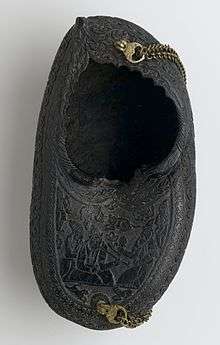 Kashkul with portrait of dervishes and a mounted falconer, A.H. 1280. Brooklyn Museum.
Kashkul with portrait of dervishes and a mounted falconer, A.H. 1280. Brooklyn Museum.
References
This article incorporates text from the ARKive fact-file "Lodoicea" under the Creative Commons Attribution-ShareAlike 3.0 Unported License and the GFDL.
- Fleischer-Dogley, F.; Huber, M.J. & Ismail, S. (2011). "Lodoicea maldivica". IUCN Red List of Threatened Species. 2011: e.T38602A10136618. doi:10.2305/IUCN.UK.2011-2.RLTS.T38602A10136618.en.
- "The Plant List: A Working List of All Plant Species". Retrieved May 16, 2014.
- John Craig,A new universal etymological technological, and pronouncing dictionary of the English language 1859
- JOURNAL OF THE PROCEEDINGS OF THE LINNEAN SOCIETY OF LONDON - BOTANY Vol. 9 (1866) p. 260.
- BIOTROPICA Vol. 15 # 1 (March 1983) p. 18 Fig 3
- E.J.H. Corner, NATURAL HISTORY OF PALMS (Berkeley: Univ. Calif. Press, 1966) pp. 314-315.
- Rene Coativy in THE PALM JOURNAL # 195 (Summer 2010) p. 6 plus photo inside front cover p. 1
- "Royal honeymooners' 'erotic' souvenir". BBC News. 16 July 2011.
- Edwards, Peter J.; Fleischer-Dogley, Frauke; Kaiser-Bunbury, Christopher N. (2015). "The nutrient economy of Lodoicea maldivica, a monodominant palm producing the world's largest seed". New Phytologist. 206 (3): 990–999. doi:10.1111/nph.13272. PMID 25616088.
- Proctor, J. (1984). "Vegetation of the granitic islands of the Seychelles". In Stoddart, D. R. (ed.). Biogeography and Ecology of the Seychelles Islands. W. Junk. ISBN 978-90-6193-881-1. OCLC 906429733.
- Ecott, Tim (16 July 2011). "Royal honeymooners' 'erotic' Seychelles souvenir". BBC - From Our Own Correspondent. Retrieved 17 July 2011.
- Uhl and Dransfield, 1987.
- Wise, R. (1998). A Fragile Eden. New Jersey: Princeton University Press.
- Science News (May 16, 2015) p.5.
- https://www.newscientist.com/article/dn26930-the-secret-of-the-worlds-largest-seed-revealed/
- Edwards, Kollmann & Fleischmann's selective review of the biology of the species (2002)
- Beaver and Chong Seng, 1992
- "Vaginula seychellensis". www.safari-afrika.de. Retrieved 2016-04-04.
- Adam Leith Gollner, The Fruit Hunters, a story of nature, adventure, commerce and obsession, page 114. Scribner 1999, ISBN 978-0-7432-9694-6
- Lodoicea media from ARKive
- Xavier Romero-Frias, The Maldive Islanders, A Study of the Popular Culture of an Ancient Ocean Kingdom. Barcelona 1999, ISBN 84-7254-801-5
- Gerlach, J. (1997). Seychelles Red Data Book. Seychelles: The Nature Protection Trust of the Seychelles.
- Seychelles: Jewel of a Lost Continent. Natural World. BBC. 10 December 2000.
- Shiv Sahay Singh. "India's only double coconut tree artificially pollinated".
- Arkive: Lodoicea maldivica
- Palm Society of Australia: Lodoicea maldivica description and photo gallery
- Hutchinson, 1959, The Families of Flowering Plants (2nd ed.)
- Fleischer-Dogley, F. (2006). Towards sustainable management of Lodoicea maldivica (Gmelin) Persoon, PhD thesis, University of Reading, UK.
External links
| Wikimedia Commons has media related to Lodoicea maldivica. |
